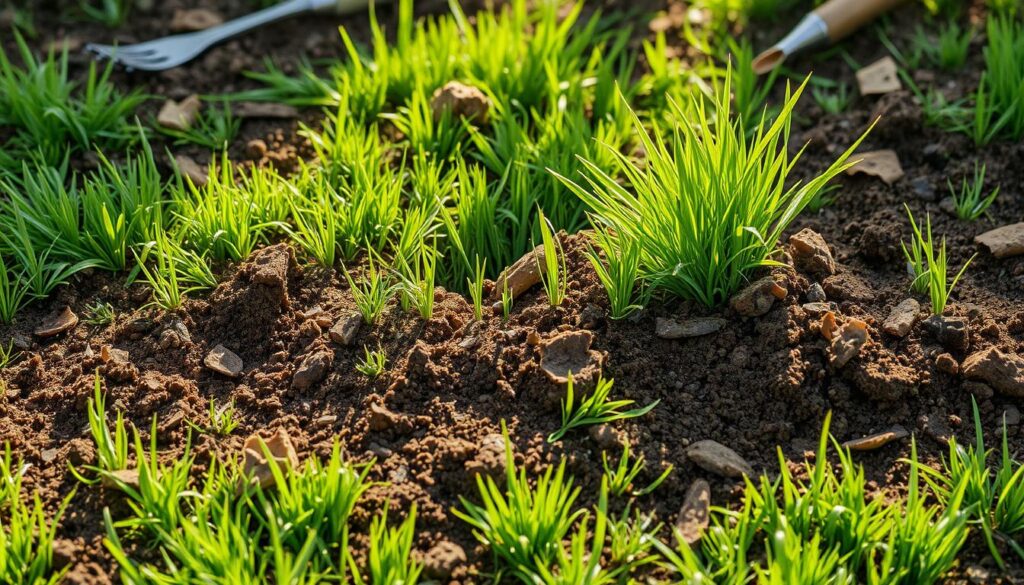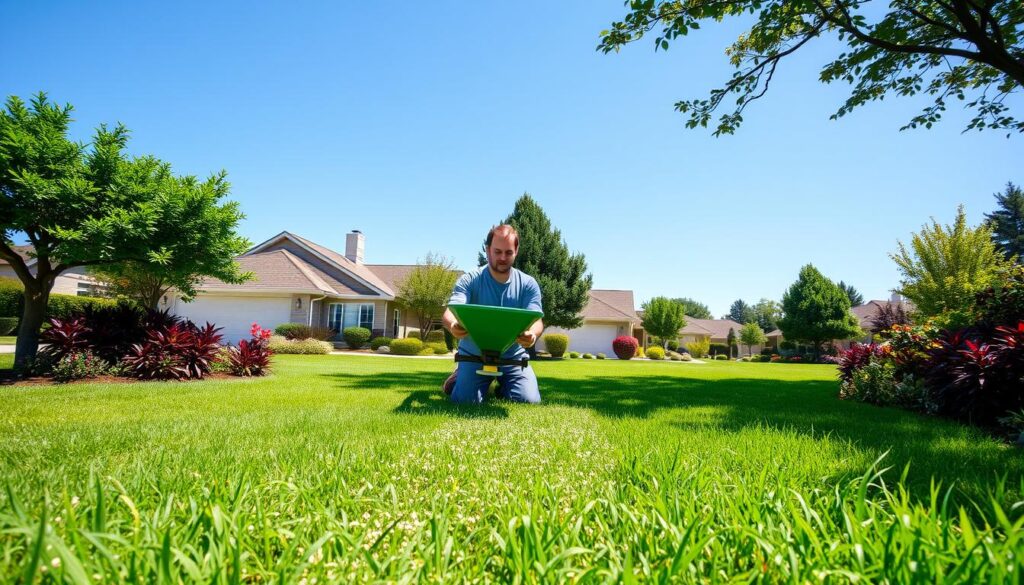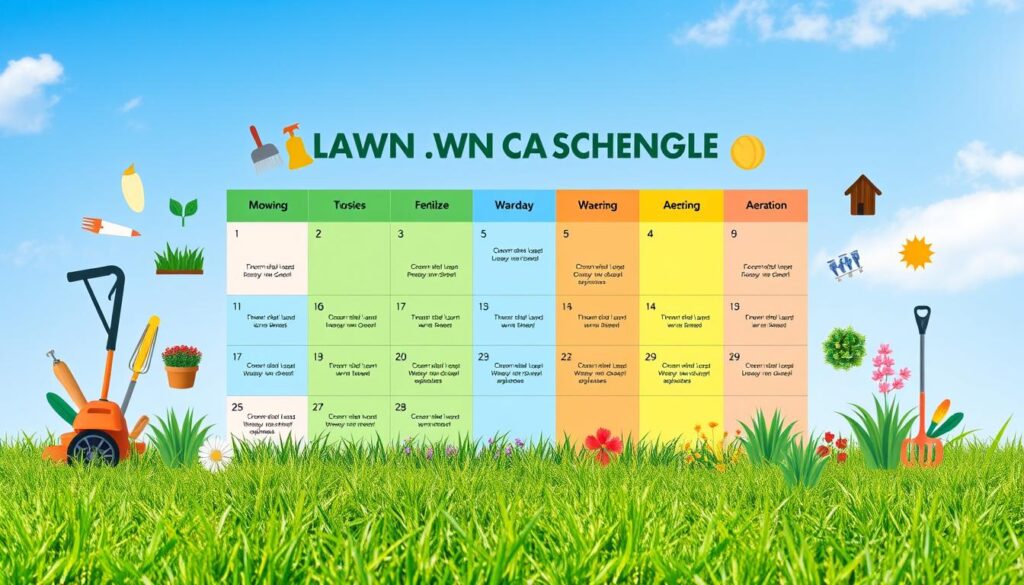Imagine your backyard after a hot summer. It looks like a dry, empty space with weeds. But, with the right steps, it can turn into a lush green area with flowers. This backyard transformation is possible with the right knowledge and effort.
In this guide, we’ll share lawn care tips to help you achieve this. We’ll cover soil preparation and choosing the best grass seed for your area. With patience and hard work, you’ll enjoy a beautiful outdoor space for years.

Key Takeaways
- Aeration is crucial for successful lawn renovation projects.
- Thatch and moss buildup can hinder new grass growth.
- Choose grass seed based on local climate and soil conditions.
- Composting enriches the soil and reduces reliance on synthetic fertilizers.
- Regular maintenance practices are essential for a healthy lawn.
Understanding Soil Preparation for Lawn Success
Getting your soil right is key to a healthy lawn. It’s all about improving soil quality for lush grass. We’ll cover how to check your soil, improve drainage and aeration, and why soil testing is crucial for grass health.
Assessing Your Soil Quality
Checking your soil means looking at its makeup, texture, and how well it drains. Knowing if your soil is sandy, clay-heavy, or loamy helps pick the right grass. A gardening guide can help you understand your soil better.
Improving Soil Drainage and Aeration
Aeration helps your soil drain better, letting grass roots breathe and get nutrients. Methods like core aeration remove soil plugs to reduce compaction and improve water absorption. These steps are vital for a strong, healthy lawn. Adding healthy lawn tips like aeration and top-dressing can make your lawn even better.
Soil Testing: The Key to Healthy Grass
Soil testing is a must to know your soil’s nutrient levels and pH balance. Homeowners should take samples from different parts of their yard and get them tested. This gives you the info you need to add the right nutrients and fertilizers, helping your lawn grow organically.
| Soil Type | Characteristics | Ideal Grass |
|---|---|---|
| Sandy | Poor nutrient retention, good drainage | Couch Grass |
| Clay | High nutrient retention, poor drainage | Buffalo Grass |
| Loamy | Balanced nutrient retention and drainage | Zoysia |
From Bare Soil to Lush Lawn: A Step-by-Step Transformation Guide
Starting your lawn transformation begins with picking the right grass seed. Knowing the differences in grass types is key for a beautiful lawn. Your local climate, the grass type, and your lawn’s environment are all important. Choosing the right seed helps your lawn grow well and makes lawn care easier.
Choosing the Right Grass Seed
Understanding your local weather is crucial when starting a new lawn. For example, Kentucky bluegrass does well in sunny spots, while perennial ryegrass likes shade. Knowing this helps you pick the best seed for a lush, green lawn that fits your property.
Seed Mixtures vs. Seed Blends: What You Need to Know
It’s important to know the difference between seed mixtures and blends for lawn care. Mixtures have the same type of grass, for a uniform look. Blends mix different types, like Kentucky bluegrass and perennial ryegrass, for better pest resistance.
| Grass Type | Best Conditions | Benefits |
|---|---|---|
| Kentucky Bluegrass | Full Sun | Durable, lush, and rich green |
| Perennial Ryegrass | Shade/Trouble Areas | Fast germination, good for overseeding |
| Bermudagrass | Warm Climates | Heat resistant, establishes quickly |
| Tall Fescue | Drought Prone Areas | Deep roots, adaptable to various soil types |
For the best results, use a grass planting guide made for your area. This guide helps you pick the right seed for your lawn’s needs. It leads to a thriving landscape.
Effective Seeding Techniques for a Thriving Lawn
Choosing the right seeding techniques is key for a lush lawn. Good strategies help spread seeds evenly and grow strong grass. This guide will show you how to sow, water, and care for your lawn.
Sowing Seeds: Tips for Even Distribution
Even seed distribution is crucial for growth. Start by splitting your seed into two parts. Sow one part in one direction and the other in a perpendicular direction. A broadcast spreader helps place seeds accurately and prevents overcrowding.
Before sowing, check the weather. In the north, plant in spring and fall. In the south, plant in spring and early summer.
Creating a Protective Layer Over Seeds
After sowing, cover the seeds with a thin layer. Use mulch or soil to protect them from weather and animals. The layer should be just a quarter-inch deep to let sunlight and water through.
This layer is key for new grass to grow well and germinate quickly.
Watering Strategies for New Grass
Watering new grass right is important. Keep the soil moist to help seeds germinate. Use light, frequent watering sessions.
As the grass grows, water less often but deeper. This helps the grass grow strong and sustainable.

| Technique | Description | Benefits |
|---|---|---|
| Even Seed Distribution | Dividing seeds and using perpendicular sowing strategies. | Maximizes coverage and promotes strong growth. |
| Protective Layer | Covering seeds with a light layer of soil or mulch. | Protects from wildlife and environmental stress. |
| Watering Techniques | Frequent, light watering, tapering as grass grows. | Ensures consistent moisture and encourages deep roots. |
Long-Term Lawn Maintenance and Care Tips
To keep your lawn lush, you need a lawn maintenance schedule that changes with the seasons. Regular care helps your lawn stay healthy and strong. A structured plan is key to improving your lawn and managing long-term care well.
Establishing a Lawn Maintenance Schedule
A good lawn maintenance schedule covers watering, fertilizing, and mowing. It’s all about timing and being consistent:
- Spring: Start by checking your soil and adding a starter fertilizer.
- Summer: Water more often to avoid drought and use organic lawn care.
- Fall: Overseed to make your lawn thicker and stronger for winter.
- Winter: Reduce foot traffic and get ready for next season.
Fertilization: Timing and Techniques
Good lawn fertilization is key for growth. When you fertilize matters a lot:
- Starter Fertilizer: Use it when you seed to help roots grow.
- Seasonal Applications: Fertilize based on your grass’s growth cycles.
- Fertilization Techniques: Choose methods that reduce runoff and promote absorption. Organic is best.
Mowing: Best Practices for New Grass
Right mowing practices are essential for new grass maintenance. Start mowing when your grass is about 3 inches tall. Aim for 2 inches for the best look.
- Use a sharp mower blade to avoid harming your grass.
- Leave clippings on the lawn to add nutrients and improve soil health.

Conclusion
Turning your yard into a beautiful outdoor space is possible with the right approach. Start by preparing the soil and choosing the best grass for your area. Then, use proper seeding techniques to lay the groundwork for a stunning lawn.
Using organic lawn care methods can make your yard look lush and vibrant. This approach not only beautifies your backyard but also shows your commitment to the environment.
For a healthy lawn, follow long-term care tips. Regular aeration, overseeding, and natural pest control are key. These practices help your grass grow strong and use less water than traditional methods.
Remember, patience and hard work are crucial for a thriving lawn. As you work on your outdoor space, enjoy the connection between your efforts and nature’s beauty. Your hard work will pay off, creating a beautiful lawn that showcases the benefits of organic care.
FAQ
What steps should I follow to prepare my bare soil for grass planting?
Start by checking your soil’s quality and how well it drains. Improve it with aeration and testing. Then, pick the right grass seed for your area. Use good seeding methods for the best results.
How do I know what type of grass seed is appropriate for my area?
Know your local climate. Kentucky bluegrass likes sun, while perennial ryegrass prefers shade. Local gardening tips can help choose the right grass for you.
What is the difference between seed mixtures and seed blends?
A seed mixture has different types of the same grass. A blend has different grass species. Blends, like Kentucky bluegrass and perennial ryegrass, are more resistant to pests and diseases.
How should I water my new grass after seeding?
Water lightly but often in the first weeks. This keeps the soil moist but not too wet. As the grass grows, water less but deeper to help it stay healthy.
What should I include in my lawn maintenance schedule?
Your lawn care plan should include watering, fertilizing, and mowing. Adjust it for the seasons and your grass’s needs to keep it healthy all year.
When is the best time to fertilize my lawn?
Use a starter fertilizer when you seed to help roots grow. Later, fertilize based on your grass’s growth. Always follow the fertilizer’s instructions to avoid harming your new grass.
What are the best practices for mowing new grass?
Start mowing when your grass is about 3 inches tall. Use a sharp blade to avoid damage. Returning clippings to the lawn helps keep it healthy.
How can I ensure the success of my lawn transformation project?
Success comes from good soil prep, the right grass, and proper seeding. Stick to a lawn care plan. Be patient and consistent for a beautiful lawn.
Source Links
- Revamp Outdoor Space: The Ultimate Guide To Lawn Renovation
- How to Revive a Neglected Lawn: A Step-by-Step Guide – Lawnhiro
- The Ultimate Guide to Growing a Lush Lawn Before Summer: From Bare Patches to Green Paradise
- Guide to Lawn Care: Tips for a Lush, Healthy Garden
- Sodded Lawn: Top 7 Tips for a Stunning Yard in 2024
- How to Tackle a Lawn Makeover
- Here’s How to Fix a Lawn That Needs a Total Overhaul
- How to Plant Grass Seed
- Effective Overseeding Techniques for Fall Lawn Renewal
- How to Plant Grass Seed: A Guide to Cultivating a Lush Lawn from Scratch
- The Ultimate Guide to Transforming Your Lawn by Overseeding
- Lawn Makeover: Top Strategies for Reviving a Neglected Yard – Luv-A-Lawn
- Tips for Achieving a Lush, Lively and Organic Lawn
- Grass Installation Guide: Best Tips for a Lush Lawn in 2024
- Unlocking a Lush Lawn: The Fall Benefits of Aerating and Overseeding – Nightingale Lawn & Landscape LLC




